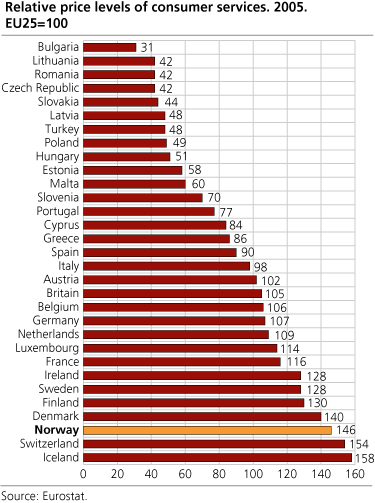Content
Published:
This is an archived release.
High price levels of Norwegian consumer services
Norway's price level of services is 46 per cent higher than the average of the 25 EU member states (EU25). Transport services, as well as recreational and cultural services, contribute to this. For communications services, however, Norway's comparative price level is closer to the European average.
In this article, we look at the comparative price levels of five selected categories of consumer services in 31 European countries (EU25, the three EFTA countries Norway, Iceland and Switzerland, as well as Bulgaria, Romania and Turkey). The figures are based on surveys carried out within the framework of the European Comparison Programme in 2004 and 2005, and were recently released by Eurostat, the European Commission's statistical office.
It is important to keep in mind that consumer services are often subsidised, and that in certain countries, the price paid by the consumer can thus be regarded as politically determined. This is particularly so in the case of public transport and recreational and cultural services. The results presented in this article are based on the consumer's cash outlay, even in the case of subsidised services.
The chart above shows the overall comparative price levels of services, including several groups of services that will not be discussed below, such as rentals and the maintenance and repair of dwellings, cars and household equipment.
The Nordic countries, Switzerland and Ireland come out on top, with a price level far above the EU25 average. In several of the new EU member states in Central and Eastern Europe, the comparative price level is still less than half the EU average. The price level of services tends to correlate with a country's income level. Services are often labour intensive, meaning that labour costs make up a considerable portion of the cost of providing them. Furthermore, consumer services are less exposed to global competition than consumer goods. For example, consumers will normally not consider going to a hairdresser abroad in order to have a haircut, whereas many groups of consumer goods are traded relatively freely across international borders.
Energy: Denmark heads price comparison
Denmark comes out with the highest comparative price level of energy, 55 per cent above the EU25 average. This is partly due to the country's high taxation of electricity and gas. Norwegian energy prices are 19 per cent above the European average, but below the price level of the Netherlands, Germany and Sweden. "Energy" in this context means energy for consumption in private households, i.e. electricity and gas, as well as heating oil, solid fuels and heat energy. Fuels for motor vehicles are not included.
High prices of transport services in Norway
Transport services are relatively expensive in Norway, with a price level 69 per cent above the European average and surpassed only by Iceland. Land-based public transport in particular contributes to this, while air travel is relatively cheaper. There are considerable differences between the countries in the survey: Bulgaria, the country with the lowest price level of transport services, is no less than 64 per cent below the EU25 average. The Baltic countries, especially Latvia and Lithuania, also have very low price levels of transport services.
Low price levels of communication services in the Nordic countries
Sweden, Finland and Denmark, generally regarded as high-cost countries, stand out with remarkably low price levels for postal and telecommunications (including internet) services. The three countries come out at 25, 22 and 18 per cent below the EU25 average. It seems that low mobile phone charges are the main reason for this. Norway's price level is 9 per cent above the EU25 average. The comparative price levels for communications services seem to vary less among countries than for many other groups of consumer services.
Norway heads comparison of recreational and cultural services
Norway's price level of recreational and cultural services is the highest among the countries surveyed, 50 per cent above the EU25 average. Iceland, Switzerland and Denmark also stand out with high price levels, 47, 35 and 30 per cent above the average, respectively. This group comprises a variety of services like sports activities, fitness centres, cinemas and theatre performances.
Hotel and restaurant services remain expensive in the Nordic countries
Iceland in particular, but Denmark and Norway as well, all stand out with high prices of hotel and restaurant services. For this group of services, Iceland is 91 per cent more expensive than the European average, Denmark 49 per cent and Norway 48 per cent. In the case of Norway, restaurant prices in particular contribute to this, and it seems likely that the high Norwegian excise duties on alcoholic beverages partly explain the country's high price level. Among the new EU member states, the Czech Republic and Slovakia have the lowest comparative price levels, about one third of Norway's. Restaurant services in this context include food and beverages served at restaurants, cafeterias, cafés, pubs, bars and kiosks, as well as take-away services. Hotel services include not only regular hotels, but also youth hostels and camping sites.
Read more in Eurostat 's " Statistics in Focus "
Tables:
- Table 1 Relative price levels of energy, Europe. 2005. EU25=100
- Table 2 Relative price levels of transport services. 2005. EU25=100
- Table 3 Relative price levels of communication services. 2005. EU25=100
- Table 4 Relative price levels of recreational and cultural services. 2005. EU25=100
- Table 5 Relative price levels for restaurant and hotel services. 2005. EU25=100
The statistics is now published as Comparison of price levels in Europe.
Contact
-
Statistics Norway's Information Centre
E-mail: informasjon@ssb.no
tel.: (+47) 21 09 46 42

